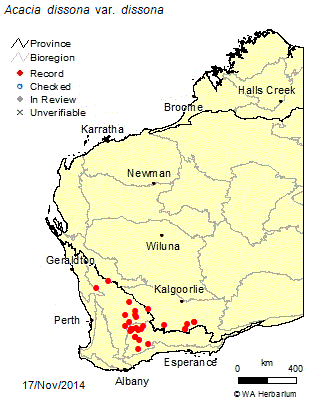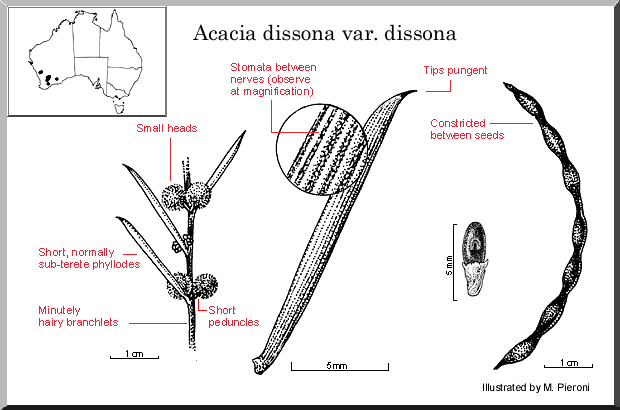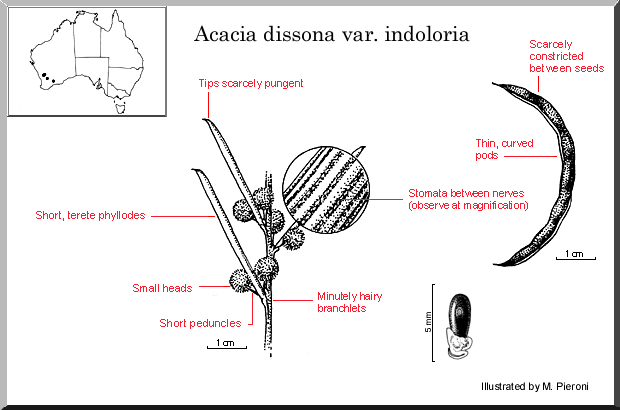Difference between revisions of "Acacia dissona"
(→Geographic distribution) |
(→Identification) |
||
| Line 41: | Line 41: | ||
== Identification == | == Identification == | ||
| + | |||
| + | Comprises two closely related varieties: | ||
| + | |||
| + | ===Acacia dissona var. dissona=== | ||
| + | [[Phyllodes]] subterete, 2–4 cm long, contracted to sharply pungent apex; nerves and internerve spaces often uniform in colour; stomata sometimes tuberculate. Pods distinctly constricted between the seeds, sparingly appressed-puberulous. Seeds 4.5 mm long; aril long-conical. | ||
| + | |||
| + | Disjunct, occurring from Merredin- Southern Cross S to near Ongerup with outliers in the Coorow-Wanarra area (c. 250 km due NW of Merredin) and the Norseman area (c. 350 km due NE of Ongerup). Grows in a variety of soils, often clay, in eucalypt woodland and mallee. | ||
| + | |||
| + | [[File:Dissona var dissona.jpg]] | ||
| + | ===Acacia dissona var. indoloria=== | ||
| + | |||
| + | [[Phyllodes]] terete, mucronate to mucronulate, innocuous to coarsely pungent; nerves paler than internerve spaces in mature phyllodes. Pods scarcely constricted between seeds, sparsely appressed-puberulous, at least between seeds. Seeds 2.5–3.5 mm long, with a broadly obtuse, crested aril. | ||
| + | |||
| + | Disjunct, occurring at Ballidu- Mollerin (c. 75- 145 km due E of Moora), Bruce Rock- Muntadgin (Muntadgin is c. 45 km due NE of Bruce Rock) and Frank Hann Natl Park (located 30- 110 km ENE of Lake King). Grows in sand, sandy loam and loam, mostly in open mallee. | ||
| + | |||
| + | [[File:Dissona var indoloria.jpg]] | ||
| + | |||
| + | The differences separating the two varieties comprising this species are indicated in the key. They are obviously closely related, with most of the differences in the pods and seeds. | ||
| + | |||
| + | Also resembles [[Acacia kalgoorliensis]] which has longer phyllodes with protracted, long-spinose tips. | ||
== Alkaloid content == | == Alkaloid content == | ||
Revision as of 12:17, 11 January 2015
Contents
General Plant Info
Low-domed to narrowly obconic, dense shrubs 0.5-2 m tall, branches often ± contorted. Bark light grey, finely longitudinally fissured at base of trunk, smooth on branches. Branchlets more or less ridged, with very short, appressed, straight to shallowly-curved hairs. Stipules persistent, triangular. Phyllodes sub-terete or terete, 2-4 cm long, 1-1.5 mm wide, l:w = 15-30, rigid, inclined to erect, straight or nearly so, green, glabrous or pulvinus often puberulous adaxially; apex more or less sharply pungent or only mucronate to mucronulate; nerves numerous, closely parallel, raised, sometimes paler than inter-nerve spaces; stomata raised in inter-nerve spaces, sometimes appearing as tubercles; pulvinus 0.5-2 mm long, sometimes not well differentiated, usually expanded at base; gland small, near middle of blade on adaxial surface. Peduncles 2 in each axil, 2-4(5) mm long, glabrous; heads globular, golden, 5-6 mm diam. (fresh), 3-4 mm diam. (dry), 15-20-flowered; bracteoles linear. Flowers 5-merous. Sepals c. 1/2 as long as petals, free, linear, ciliolate apically. Petals free, elliptic, glabrous. Pods linear, raised over and variably constricted between seeds, to 6 cm long and 2.5 mm wide, thin-crustaceous or thin-coriaceous, moderately curved, somewhat loosely and irregularly reticulate-nerved, ± appressed-puberulous. Seeds longitudinally arranged in pods, oblong-elliptic, 2.5-4.5 mm long, 1.5 mm wide, 1 mm thick, dark-brown, glossy or semi-glossy; aril terminal, conical or broadly rounded and crested, 1/2-2/3 as long as seed, pale yellow.
Flowering
Most flowering specimens have been collected in September and October, but the northern ones (from the Coorow-Wanarra area) were collected in July and August. Pods with mature seeds have been collected in December.
Phyllodes
2-4 cm long, sub-terete, contracted to short, more or less sharply pungent tips, nerves and inter-nerve spaces uniform in colour, stomata sometimes tuberculate.
Peduncles
2-5 mm long.
Pods
distinctly constricted between the seeds, sparingly appressed-puberulous
Geographic distribution
Discontinuous in southwest Western Australia in the Merredin-Southern Cross area south to near Ongerup with outliers in the Coorow-Wanarra area (c. 250 km northwest of Merredin) and in the Norseman area (c. 350 km northeast of Ongerup).
Identification
Comprises two closely related varieties:
Acacia dissona var. dissona
Phyllodes subterete, 2–4 cm long, contracted to sharply pungent apex; nerves and internerve spaces often uniform in colour; stomata sometimes tuberculate. Pods distinctly constricted between the seeds, sparingly appressed-puberulous. Seeds 4.5 mm long; aril long-conical.
Disjunct, occurring from Merredin- Southern Cross S to near Ongerup with outliers in the Coorow-Wanarra area (c. 250 km due NW of Merredin) and the Norseman area (c. 350 km due NE of Ongerup). Grows in a variety of soils, often clay, in eucalypt woodland and mallee.
Acacia dissona var. indoloria
Phyllodes terete, mucronate to mucronulate, innocuous to coarsely pungent; nerves paler than internerve spaces in mature phyllodes. Pods scarcely constricted between seeds, sparsely appressed-puberulous, at least between seeds. Seeds 2.5–3.5 mm long, with a broadly obtuse, crested aril.
Disjunct, occurring at Ballidu- Mollerin (c. 75- 145 km due E of Moora), Bruce Rock- Muntadgin (Muntadgin is c. 45 km due NE of Bruce Rock) and Frank Hann Natl Park (located 30- 110 km ENE of Lake King). Grows in sand, sandy loam and loam, mostly in open mallee.
The differences separating the two varieties comprising this species are indicated in the key. They are obviously closely related, with most of the differences in the pods and seeds.
Also resembles Acacia kalgoorliensis which has longer phyllodes with protracted, long-spinose tips.
Alkaloid content
Other uses
Extraction
Cultivation
Grows on clay, loam, and sandy soils in eucalypt woodland or mallee, sometimes dominated by Eucalyptus salmonophloia.


